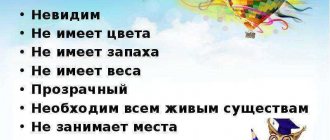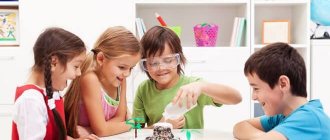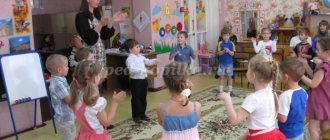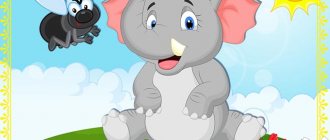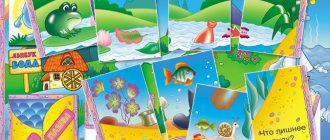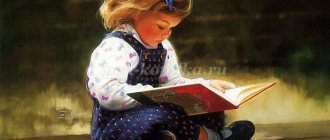Summary of a lesson on experimental activities in the senior group “Experiments with flour”
Lesson summary on experimental activities in the senior group
"Experiments with flour"
Experiments with flour
Goal: To familiarize children with the properties of flour through children's experimentation. Educational objectives: Expand and clarify children's knowledge about grain crops. Introduce the properties of flour. Continue to develop in children the ability to foresee the consequences of actions. Developmental tasks: Develop cognitive interest in experimentation, the ability to draw conclusions. develop auditory, visual, tactile analyzers; develop attention, thinking, memory.
Educational tasks. Develop partnerships in children when working in pairs. Cultivate respect for the work of adults and respect for bread. Preliminary work: Viewing the presentation “Cereal Crops” Excursion to a bread store, kneading salt dough.
Vocabulary work: bakery products, confectionery products. ingredients, grains, sieve..
Demonstration material: Blank for a crossword puzzle. Pictures of fields with grain crops. Exhibition of flour products Sugar, yeast. Wheat, oats - shelled and unhulled
Handouts: Flat plate, magnifying glass, spoon, jug of water, 2 napkins. deep bowls - set for 2 children
Equipment: Coffee grinders (Manual and electric)
Methods and techniques: Verbal: conversations with children, stories, explanations, questions, clarifications, pedagogical assessment, instructions. Easily visible spikelets. Grain grains (wheat, barley, rice, oats, corn, rye), pictures. Practical: elementary experiments,
Progress of the lesson. Organizing time.
I received a strange letter. There are four empty cells in the letter - an encrypted word. And only by completing certain tasks will you help me find out what is written in it.
The first cell contains the letter that is hidden in the word PASTA and is in first place. (M) In the second cell there lives a letter that is hidden in the word BULKA and is in second place. (U) In the third cell there lives a letter that is hidden in the word BUBLIK and stands at the end of the word. (K) In the fourth cell there lives a letter that is hidden in the word BATON, and is in second place in it. (A) - Let's read what word we got! (FLOUR)
Also an interesting lesson on experimentation for the preparatory group: Notes on experimental activities in the preparatory group of the preschool educational institution “In secret to the whole world”
– What is flour needed for? Answers: -In order to bake bread, loaf, rolls, cookies - Well done! You all answered correctly. Flour is needed to bake bakery, confectionery, and pasta products.
Practical part - I propose to study the properties of flour.
Gently smell the flour. Does flour have a smell? (Yes, flour has a smell, but it’s something special) - Flour has a smell.
Pour flour from a glass through a strainer into a plate. What happens to the flour? (Sprinkles) - Free-flowing flour.
Take a pinch of flour and tell me how you felt? What kind of flour? (Light, soft, fluffy, airy) – Flour – soft, fluffy.
Level the flour in the plate by moving the tray slightly to the sides. Try drawing something on the flour with your finger. – It turns out you can write and draw on flour.
Place a spoonful of flour in a glass of water and stir gently. What happened to the flour? (Dissolved) - Add two more spoons. Stir and determine what happened? (It turned out to be a liquid dough) - The mixture became viscous, sticky, dense, thick. Thus, the dough for baking is kneaded.
In order to bake fluffy buns, various ingredients are added to the dough: butter, salt, sugar, eggs, yeast. – Now, let’s add a little sugar and yeast to one of your glasses. And put one glass with yeast and sugar on the radiator, and the second with only flour. And let's wait a little.
Physical education minute. Didactic exercise with a ball. (The presenter, asking a question, throws the ball to the child, who returns the ball with the answer, etc.)
Where did the bread come from? - from the shop. How did you get into the store? - from the bakery. What do they do in the bakery? - bake bread. Of what? - from flour. What is flour made of? - from grain. Where does the grain come from? - from an ear of wheat. Where does the wheat come from? – grew up in the field. Who sowed it? - grain growers.
- Guys, what do you think flour is made from? (from grain) - What grain is flour made from? (Wheat. Oats. Barley. Rice. Corn. Rye. Buckwheat) - That's right, guys! Many grain crops are grown and various products are baked from them. Name what bakery products you know. (Bread, loaf, etc.), confectionery..., pasta....
– You have different grains in your plates. Let's look at them with a magnifying glass and determine what they are called. (Oats, wheat, rice, corn, buckwheat). – Let’s try to make flour from oats and wheat ourselves, using manual and electric coffee grinders. - Let's see what kind of flour we got. (Children's answers) - Let's compare it with store-bought flour. (Children's answers)
- Why isn’t she white? Before making white flour, the grains go through several stages of sorting and purification; and only after that the grains produce pure white fluffy flour, the kind we buy in stores.
In our country, the most common bread is wheat and rye. Coarse rye bread is especially useful; it contains many microelements necessary for our body.
No wonder people say: Bread is the head of everything. Bread and water are healthy food. It's a bad lunch if there's no bread.
In order for bread to come to our table, many people work on it. These are tractor drivers, combine operators, grain growers, millers, bakers, drivers, sellers, etc.
Take care of our bread, don’t waste your bread! Respect our bread, do not play with bread. You can't throw away bread! Take care of your bread, Friends!
– Now let’s all make a Spikelet out of salted dough together. (prepared dough)
